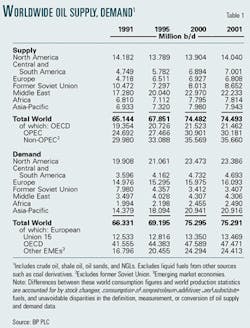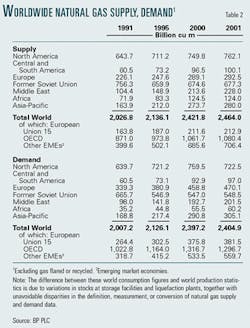Global energy consumption grew only marginally in 2001, increasing by 0.3% and marking the third consecutive year that consumption rose by less than 0.5% year-on-year.
Such a modest increase was the result of an overall downturn in the world economy that was exacerbated by the aftermath of the Sept. 11, 2001, terrorist attacks on the US, BP PLC reported late last month in its annual statistical review of world energy.
Demand growth was particularly low in most of Asia and in the Americas, the report noted. "North American energy consumption fell by 2.4%, the first drop in a decade," the report stated, adding, "However, demand in China rose by 4.3%, and the 1.2% rise in the (former Soviet Union) was the third consecutive annual increase in the region as economic recovery continued."
Despite the events that caused lackluster growth in energy consumption, "the markets continued to operate, and supplies of oil and gas were maintained," said John Browne, BP chief executive. Browne attributed the sustained level of worldwide energy supply during 2001 to the diversity of energy supplies. "Nations need not be overconcerned about energy security in the face of unexpected world events," he said, adding that the US obtained 55% of its oil supplies from 60 countries in 2001, but none of the suppliers accounted for more than 16% of the total.
"There is oil and gas from the deep water of the Gulf of Mexico and the Caspian and Russia, oil from Angola and gas from Indonesia and Trinidad," Browne said. "Those concerned about energy should concentrate their efforts on maintaining that diversity," he added.
Fuel consumption
The performance among various energy sources were mixed in 2001, BP reported.
While worldwide consumption of natural gas, coal, and nuclear power grew, consumption of oil and hydroelectricity were down for the first time in years.
Total world oil use reached 75.291 million b/d, a decline of 0.2% from 2000 figures (Table 1). The decline was the first seen for oil use since 1993, BP said.
The only two regions to register increases in oil consumption were Europe and Africa. Africa's oil consumption rose 0.8% year-over-year, and Europe's oil use increased 0.6%.
Meanwhile, "Demand weakness was particularly pronounced in Asia, where consumption fell by 0.5% compared to a 10-year trend of 3.6% annual growth," the report said.
Central and South America also saw a percentage decrease, down 1.1%. Percentage decreases were also seen in the Middle East, down 0.6%, the FSU, down 0.4%, and North America, down 0.3%.
North America accounted for 30.4% of total world use in 2001, vs. 27.7% for Asia-Pacific, 21.7% for Europe, 6.2% for Central and South America, 5.9% for the Middle East, 4.8% for the FSU, and 3.3% for Africa.
Natural gas consumption rose in 2001, but only marginally, by 0.3%, which was down markedly from the 4.3% increase the previous year, BP reported.
"While consumption in some parts of the world, particularly Asia, remained strong, demand was depressed in all three of the world's largest gas markets-the US, Russia, and the UK," the report said, adding that the gas demand decline in North America was "particularly severe" at a 4.9% decline year-over-year (Table 2).
Africa registered the largest increase in natural gas consumption, up 8.2% for 2001.
Increases were also seen in the Asia-Pacific region, up 5%, the Middle East, up 4.5%, Central and South America, up 4.1%, Europe, up 2.4%, and the FSU, up 0.3%.
Worldwide consumption of coal was up 1.7%, marking the second consecutive year of growth, BP said.
The rise in coal consumption was fueled by a 5.4% increase in China, which accounts for 23.1% of worldwide coal demand. "This was the first increase in Chinese coal demand for 4 years," BP said.
Coal consumption in the rest of the world, meanwhile, was relatively flat, falling in North America, Europe, and Africa and rising in Central and South America, the FSU, the Middle East, and Asia-Pacific.
Consumption of nuclear power was up by 2.8% last year, BP reported. Meanwhile, hydroelectric power usage fell for the first time since 1992, by 3.7%.
"Dry conditions led to sharp falls in the US (down 22.7%), Brazil (down 11.7%), and Canada (down 7.4%)," BP noted. Nuclear and hydroelectric energy each still account for about 6% of total world energy demand, BP said.
Energy output
Most members of the Organization of Petroleum Exporting Countries voluntarily restricted production during 2001.
However, the 2.7% decline (about 720,000 b/d) in OPEC oil production, mainly from Saudi Arabia and Iraq, was "almost exactly offset of increases in non-OPEC production," BP noted. "The great majority of this increase came from a second year of strong production growth from the FSU, particularly as (an) increase of over 500,000 b/d from Russia," BP said.
Showing "modest" production volume increases outside OPEC were Mexico (3.1%), Brazil (5%), Equatorial Guinea (60.1%), and Norway (1%).
These increases, however, were offset by declines in production from Colombia, down 12.1%, Australia, down 10.1%, and the UK, down 6.6%, BP said. US oil production was down 0.3% last year.
Worldwide production of natural gas was up 1.7%, with seven countries reporting increases of at least 10%. North America's production of gas grew by 1.6%, BP said.
The fastest-growing region for gas production was the Middle East, up 6.7%. Expansions in LNG export projects in both Qatar and Oman led this growth, BP said.




